












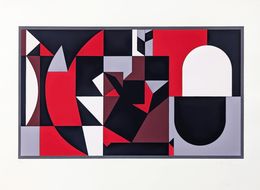






Les années cinquante 2
Victor Vasarely
Print - 70 x 57 x 0.2 cm Print - 27.6 x 22.4 x 0.1 inch
$2,204









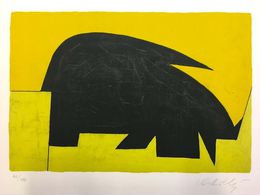


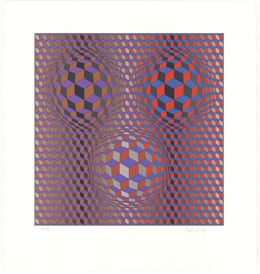

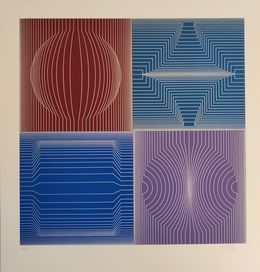










Planetarische Folklore
Victor Vasarely
Print - 66 x 62.5 x 0.1 cm Print - 26 x 24.6 x 0 inch
$16,075
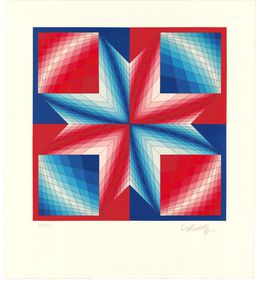















Movement is in time, not in a single space. We are in the world instead of staying on the surface.
Biography
Victor Vasarely is a French-Hungarian painter. He was born and raised in Pecs, Hungary, then studied medicine in Budapest. In 1927, he abandoned medicine and opted for traditional academic painting instead. He trained in Hungary at the Pololini-Volkmann Academy and in 1929, he enrolled at Sándor Bortnyik's "workshop", which was widely recognized as the center of Bauhaus studies in Budapest. By 1931, he was established in Paris and worked in advertising from 1936-44 where he designed important graphic works deriving from his own semantics. In 1944, he participated in the founding of the Denise René gallery, which he inaugurated with his first exhibition. A series of portraits executed in 1946, testified to his preoccupations in a post-Cubist spirit, but sometimes curiously "exploded": Seven Years of Misfortune.
Vasarely's excellence in drawing was quickly noticed. In 1929 he painted his Blue Study and Green Study. In 1930 he married his fellow student Claire Spinner (1908-1990). Together they had two sons, Andre and Jean-Pierre. In Budapest, he worked for a ball-bearings company in accounting and designing advertising posters. Victor Vasarely became a graphics designer and a poster artist during the 1930's who combined patterns and organic images with each other.
He studied at the Bauhaus Muhely in Budapest and in 1930 emigrated to Paris where he developed his particular vision which stems from the idea of democratizing the art object. Influenced greatly by the problems of the world's cities, he feels his work offers a solution by presenting a clear view of the "color-surface-perception" relationship.
Vasarely left Hungary and settled in Paris in 1930 working as a graphic artist and as a creative consultant at the advertising agencies Havas, Draeger and Devambez (1930-1935). His interactions with other artists during this time were limited. He played with the idea of opening up an institution modeled after Sándor Bortnyik and developed some teaching material for it. Having lived mostly in cheap hotels, he settled in 1942/1944 in Saint-Céré in the Lot département. After the Second World War, he opened an atelier in Arcueil, a suburb some 10 kilometers from the center of Paris (in the Val-de-Marne département of the Île-de-France). In 1961 he finally settled in Annet-sur-Marne (in the Seine-et-Marne département).
Over the next three decades, Vasarely developed his style of geometric abstract art, working in various materials but using a minimal number of forms and colors.
He has used the income from the sale of these "investigations," as he calls his prints, to establish a socio-cultural foundation in Aix-en-Provence, France, for the study of the integration of plastic beauty at all levels of the urban environment. He is represented in major museums all over the world and has received many artistic and honorary awards. Among these distinctions are the French Legion of Honor, the Guggenheim Prize, and the Gold Medal of the Triennale in Milan.
On 5 June 1970, Vasarely opened his first dedicated museum with over 500 works in a renaissance palace in Gordes (closed in 1996). A second major undertaking was the Fondation Vasarely in Aix-en-Provence, a museum housed in a distinct structure specially designed by Vasarely. It was inaugurated in 1976 by French president Georges Pompidou. Sadly the museum is now in a state of disrepair, several of the pieces on display have been damaged by water leaking from the ceiling. Also, in 1976 his large kinematic object Georges Pompidou was installed in the Centre Pompidou in Paris and the Vasarely Museum located at his birth place in Pécs, Hungary, was established with a large donation of works by Vasarely. In 1982 154 specially created serigraphs were taken into space by the cosmonaut Jean-Loup Chrétien on board the French-Soviet spacecraft Salyut 7 and later sold for the benefit of UNESCO. In 1987, the second Hungarian Vasarely museum was established in Zichy Palace in Budapest with more than 400 works.
He died in Paris on 15 March 1997.
Nationality
Categories
Artistic movements
Themes






